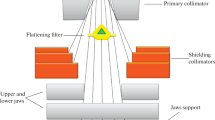Abstract
With the clinical introduction of MR-linacs, out-of-field dose (OFD) associated with head leakage/scatter (HLS), spiralling contaminant electrons (SCE) and the electron streaming effect (ESE) is of interest. To investigate HLS and SCE, EBT3 film on solid water 5.0 cm beyond each edge of a 10.0 × 10.0 cm2 field was used to determine depth-dose for 0 T and 1.5 T, in the isocentric plane. Additionally, ESE induced by the anterior imaging coil was quantified and the experimental arrangements to measure SCE and ESE were modelled using Monaco. For a clinical treatment of supraclavicular nodal disease, Monaco OFD was compared to in vivo measurements. For 0 T, depth-dose was isotropic and surface dose was approximately 4.4% of Dmax. With 1.5 T surface doses were approximately 3.8% of Dmax at ± Y (IEC61217), compared to 2.6% and 0.6% of Dmax at − X and X, respectively. For both field strengths, the TPS depth-dose variation was consistent with experimental trends; however, near surface doses calculated at ± Y differed significantly from measurements. For the field sizes investigated, measured coil ESE dose was between 9.0 and 28.0% of Dmax and Monaco coil ESE was less than measured by up to 13.0%. OFD in 0 T and 1.5 T are comparable at ± Y, inconsistent with previous work. Anterior coil ESE should be mitigated during treatment and for the clinical case investigated, in vivo OFD was within 2σ of TPS calculations. Monaco overestimates near surface SCE and underestimates coil ESE.










Similar content being viewed by others
Data availability
All data relevant to this article can be made available upon request.
References
Raaymakers B, Raaijmakers A, Kotte A, Jette D, Lagendijk J (2004) Integrating a MRI scanner with a 6 MV radiotherapy accelerator: dose deposition in a transverse magnetic field. Phys Med Biol 49:4109–4118
Raaymakers B et al (2017) First patients treated with a 1.5 T MRI-linac: clinical proof of concept of a high precision, high-field MRI guided radiotherapy treatment. Phys Med Biol 62:41–50
Raaijmakers A, Raaymakers B, van der Meer S, Lagendijk J (2007) Integrating a MRI scanner with a 6 MV radiotherapy accelerator: impact of surface orientation on entrance and exit dose due to the transverse magnetic field. Phys Med Biol 52:929–939
Snyder J, St-Aubin J, Yaddanapudi S, Boczkowski A, Dunkerley D, Graves S, Hyer D (2020) Commissioning of a 1.5 T Elekta Unity MR-Linac: a single institution experience. J Appl Clin Med Phys 21:160–172
Raaijmakers A, Raaymakers B, Lagendijk J (2005) Integrating a MRI scanner with a 6 MV radiotherapy accelerator: dose increase at tissue-air interfaces in a lateral magnetic field due to returning electrons. Phys Med Biol 50:1363–1376
Hackett S, van Asselen B, Wolthaus J, Bluemink J, Ishakoglu K, Kok J, Lagendijk J, Raaymakers B (2018) Spiraling contaminant electrons increase doses to surfaces outside the photon beam of an MRI-linac with a perpendicular magnetic field. Phys Med Biol 63:095001. https://doi.org/10.1088/1361-6560/aaba8f
Malkov V, Hackett S, van Asselen B, Raaymakers B, Wolthaus J (2019) Monte Carlo simulations of out-of-field skin dose due to spiralling contaminant electrons in a perpendicular magnetic field. Med Phys 46(3):1467–1477
Park J, Shin K, Kim J, Park S, Jeon S, Choi N, Kim J, Wu H (2018) Air-electron stream interactions during magnetic resonance IGRT: skin irradiation outside the treatment field during accelerated partial breast irradiation. Strahlenther Onkol 194:50–59
Malkov V, Hackett S, Wolthaus W, Raaymakers B, van Asselen B (2019) Monte Carlo simulations of out-of-field surface doses due to the electron streaming effect in orthogonal magnetic fields. Phys Med Biol 64:115029. https://doi.org/10.1088/1361-6560/ab0aa0
Lewis D, Micke A, Yu X (2012) An efficient protocol for radiochromic film dosimetry combining calibration and measurement in a single scan. Med Phys 39:6339–6349
Lewis D, Chan M (2015) Correcting lateral response artifacts from flatbed scanners for radiochromic film dosimetry. Med Phys 42:416–429
Hissoiny S, Ozell B, Bouchard H, Despres P (2011) GPUMCD: a new CPU-oriented Monte Carlo dose calculation platform. Med Phys 38:754–764
Ahmad S, Sarfehnia A, Paudel M, Kim A, Hissoiny S, Sahgal A, Keller B (2016) Evaluation of a commercial MRI Linac based Monte Carlo dose calculation algorithm with GEANT4. Med Phys 43:894–907
Winkel D, Bol G, Kroon P, van Asselen B et al (2019) Adaptive radiotherapy: the Elekta Unity MR-linac concept. Clin Transl Radiat Oncol 18:54–59
Ahunbay E, Peng C, Chen GP et al (2008) An on-line replanning scheme for interfractional variations. Med Phys 35:3607–3615
Berger M, Coursey J, Zucker M and Chang J (2017) Stopping power and range tables for electrons, protons and helium ions. Electronic dataset, National Institute of Standards and Technology (NIST). https://doi.org/10.18434/T4NC7P. Accessed March 2020
Acknowledgements
We would like to recognise the contribution of Jessice Lye, Reza Alignaghi Zadeh, Rob Behan and Sandie Fisher of the Olivia Newton-John Cancer Wellness and Research Centre and Mikala Wright of James Cook University.
Funding
No funding was received to assist with the preparation of this manuscript.
Author information
Authors and Affiliations
Corresponding authors
Ethics declarations
Conflict of interest
The authors have no relevant financial or non-financial interests to disclose.
Informed consent
Written consent was obtained from the patient for the use of images in this work.
Research involving human and animal rights
This article does not contain any studies with human participants or animals performed by any of the authors.
Additional information
Publisher's Note
Springer Nature remains neutral with regard to jurisdictional claims in published maps and institutional affiliations.
Rights and permissions
About this article
Cite this article
Baines, J., Powers, M. & Newman, G. Sources of out-of-field dose in MRgRT: an inter-comparison of measured and Monaco treatment planning system doses for the Elekta Unity MR-linac. Phys Eng Sci Med 44, 1049–1059 (2021). https://doi.org/10.1007/s13246-021-01039-6
Received:
Accepted:
Published:
Issue Date:
DOI: https://doi.org/10.1007/s13246-021-01039-6




